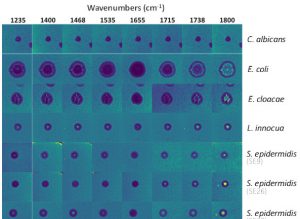Images at different wavelengths differentiate tumour cells
“The combination of a set of lasers and lens-less imaging with an uncooled bolometer matrix allows biochemical mapping over a wide field of view,” said Grégoire Mathieu of Grenoble research institute CEA-Leti. “The project showed that this experiment’s set-up coupled to machine learning algorithms can help to classify the biological cells in a fast and reproducible way.
One paper covered images from mice tissue using amide and DNA absorption bands. The team “achieved up to 94% of successful predictions of cancer cells with a population of 325 pixels corresponding to muscle tissues and 325 pixels corresponding to cancer tissues,” according to Leti. “This work may lead to the development of an imaging device that could be used for cancer diagnosis at hospitals.”
 The second paper discussed identifying bacteria in a Petri-dish using mid-infra-red lens-less multi-spectral imaging.
The second paper discussed identifying bacteria in a Petri-dish using mid-infra-red lens-less multi-spectral imaging.
Multi-spectral images of examples from seven bacteria species – column-top wavenumbers are in cm-1.
“The technique relies on the acquisition of images at eight wavelengths corresponding to relevant chemical functions,” said Leti. “It provides both morphological and discrete spectral data, which discriminates between even closely related species.”
In the proof of concept, a database containing 2,253 colonies belonging to eight different species and three strains of staphylococcus epidermidis was acquired, followed by machine-learning analysis that classified all species with an accuracy of at least 91%, said Leti.
The next step is to create a prototype working at wavelengths chosen to work on real-life samples, such as human biopsies.
